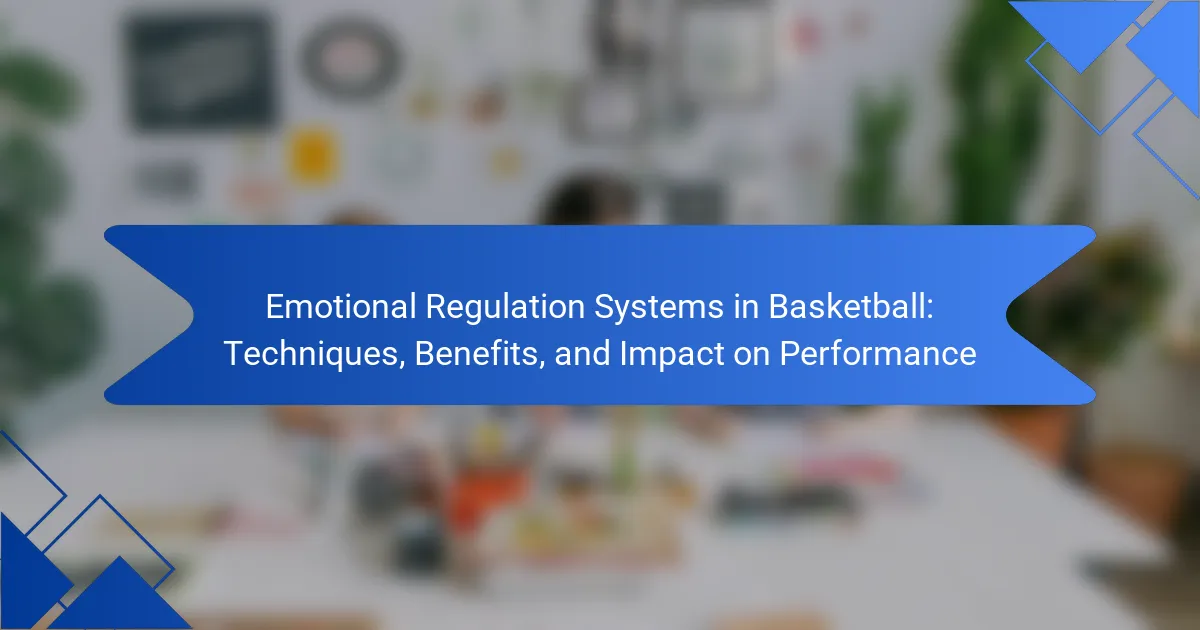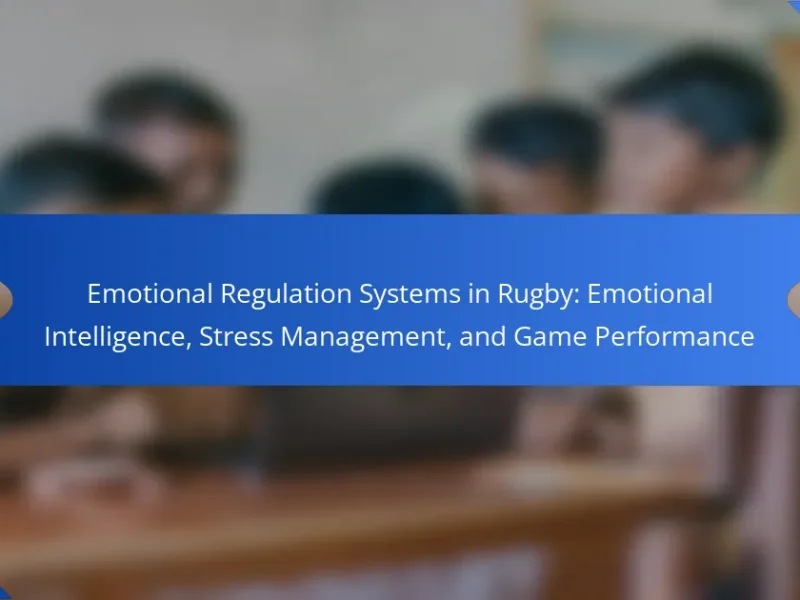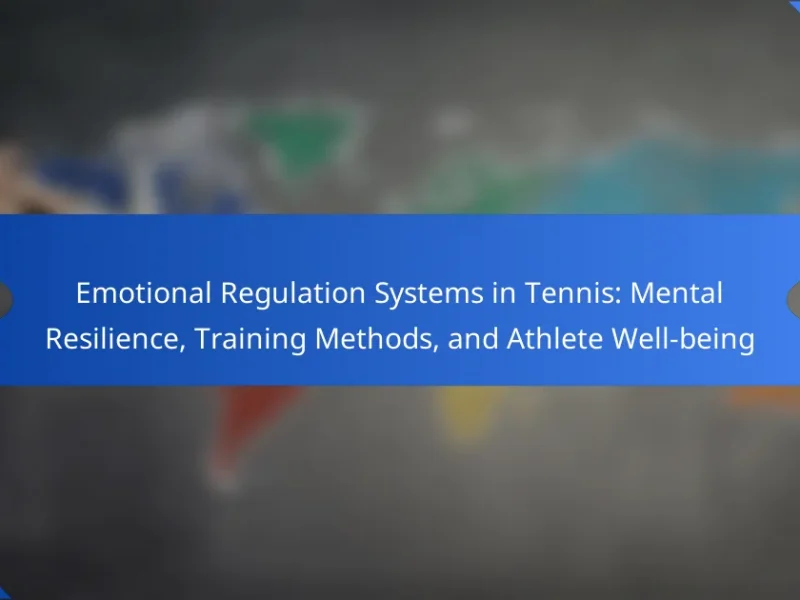Effective emotional regulation systems in basketball enhance player performance by improving focus, reducing anxiety, and fostering teamwork. Techniques such as mindfulness, breathing exercises, and cognitive restructuring play a crucial role in this process. The benefits include increased confidence, better decision-making, and improved interpersonal relationships on the court. Research highlights the positive impact of these systems on game outcomes and overall athletic resilience.
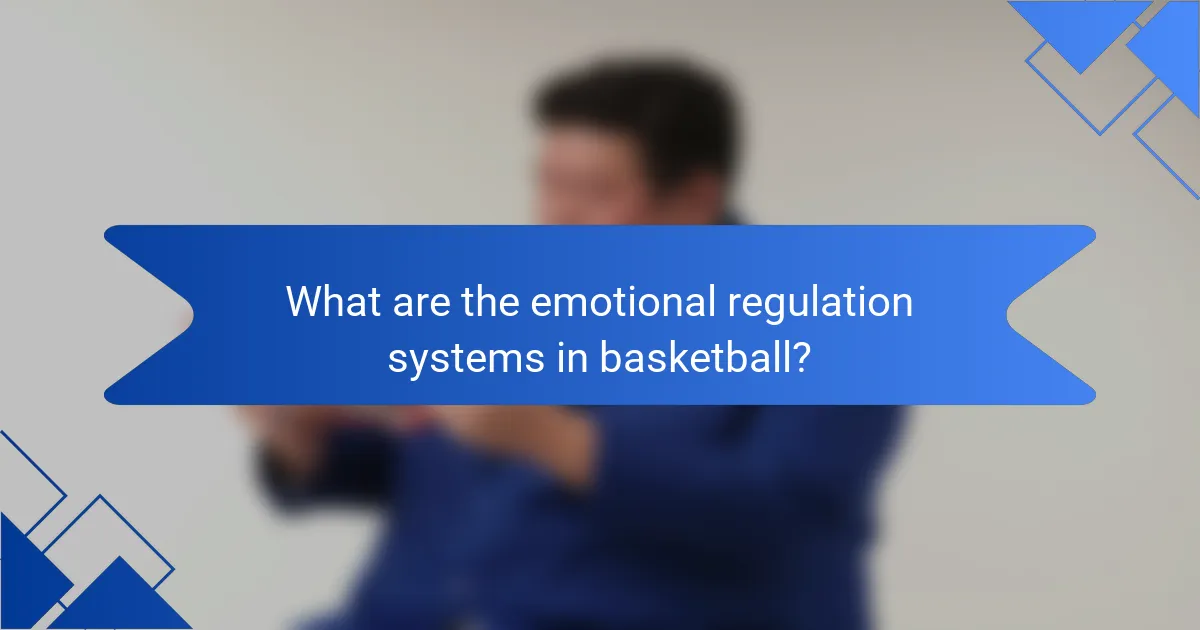
What are the emotional regulation systems in basketball?
Emotional regulation systems in basketball involve techniques that help players manage their emotions effectively during games. These systems enhance focus, resilience, and teamwork, ultimately improving performance. Techniques include mindfulness, cognitive restructuring, and breathing exercises. Benefits encompass reduced anxiety, increased confidence, and better decision-making. Research indicates that players utilizing these systems demonstrate improved game outcomes and interpersonal relationships on the court.
How do these systems impact player performance?
Emotional regulation systems significantly enhance player performance by improving focus and reducing anxiety. Techniques such as mindfulness and breathing exercises help athletes maintain composure during high-pressure situations. As a result, players experience better decision-making and increased resilience on the court. Emotional regulation contributes to consistent performance, allowing athletes to execute skills effectively even under stress.
What techniques are commonly used for emotional regulation in basketball?
Common techniques for emotional regulation in basketball include mindfulness practices, cognitive restructuring, and breathing exercises. These methods help players manage stress, maintain focus, and enhance performance during games. Mindfulness allows players to stay present, reducing anxiety. Cognitive restructuring helps in reframing negative thoughts, leading to improved confidence. Breathing exercises promote relaxation, aiding in emotional control. Overall, these techniques contribute to better decision-making and teamwork on the court.
What role does self-talk play in emotional regulation?
Self-talk significantly enhances emotional regulation in basketball by fostering focus and resilience. Positive self-talk helps athletes manage stress, maintain motivation, and improve performance under pressure. Techniques such as affirmations and cue words can create a mindset conducive to optimal performance. As a result, athletes who effectively harness self-talk often experience improved emotional stability and better game outcomes.
How can visualization techniques enhance emotional control?
Visualization techniques significantly enhance emotional control in basketball by promoting focus, reducing anxiety, and improving performance. These methods allow athletes to mentally rehearse scenarios, leading to better emotional responses during high-pressure situations. Techniques like imagery and mental simulation help players visualize successful outcomes, fostering confidence and emotional resilience. As a result, athletes can maintain composure, enhancing their overall game performance.
What breathing exercises are effective for managing emotions during games?
Breathing exercises such as diaphragmatic breathing and box breathing effectively manage emotions during games. These techniques enhance focus, reduce anxiety, and stabilize heart rates. Diaphragmatic breathing involves inhaling deeply through the nose, expanding the diaphragm, and exhaling slowly through the mouth. Box breathing consists of inhaling for four counts, holding for four counts, exhaling for four counts, and holding again for four counts. Both methods promote emotional regulation, improving overall performance in high-pressure situations.
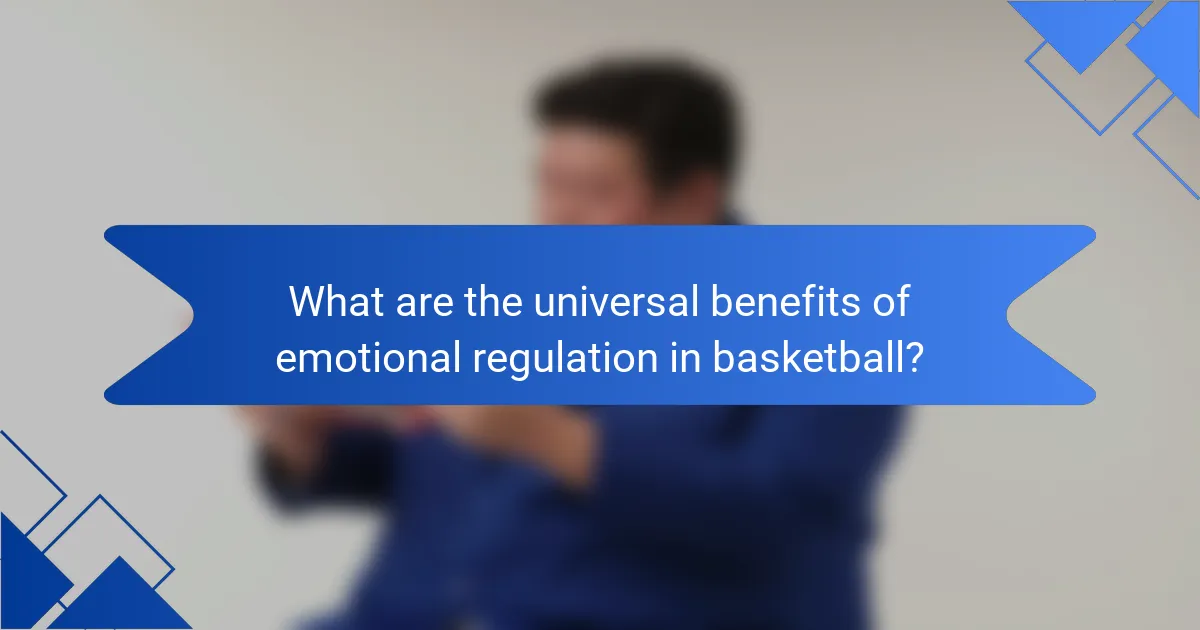
What are the universal benefits of emotional regulation in basketball?
Emotional regulation in basketball enhances performance by improving focus, reducing anxiety, and fostering teamwork. Players who manage their emotions effectively can maintain composure under pressure, leading to better decision-making and execution. This skill also promotes resilience, allowing athletes to recover quickly from setbacks. Overall, emotional regulation contributes to a more positive team environment and enhances overall game performance.
How does emotional regulation contribute to overall team dynamics?
Emotional regulation enhances team dynamics by fostering communication and collaboration. Effective emotional management leads to better conflict resolution, increased trust, and a positive atmosphere. Techniques such as mindfulness and cognitive restructuring improve players’ focus and resilience, directly impacting performance. Teams that prioritize emotional regulation often demonstrate higher cohesion and adaptability during games.
What impact does emotional regulation have on decision-making?
Emotional regulation significantly influences decision-making by enhancing focus and reducing impulsivity. In basketball, players who effectively manage their emotions are better equipped to make strategic choices during high-pressure situations. This skill can lead to improved performance metrics, such as shooting accuracy and team collaboration. Techniques like mindfulness and cognitive restructuring are essential for fostering emotional regulation, ultimately benefiting overall game outcomes.

What unique attributes differentiate emotional regulation systems in basketball?
Emotional regulation systems in basketball are differentiated by their adaptability, focus on mindfulness, and use of visualization techniques. These unique attributes allow players to manage stress and enhance performance under pressure. Adaptability helps players respond to dynamic game situations, while mindfulness promotes emotional awareness and control. Visualization techniques enable athletes to mentally rehearse scenarios, improving confidence and reducing anxiety.
How do cultural factors influence emotional regulation techniques?
Cultural factors significantly shape emotional regulation techniques in basketball. These influences affect players’ responses to stress, teamwork dynamics, and communication styles.
Cultural norms dictate what emotions are acceptable to express, impacting how athletes manage their feelings during games. For instance, cultures that value stoicism may encourage players to suppress emotions, while others may promote open expression, enhancing team cohesion.
Additionally, cultural backgrounds inform coping strategies. Athletes from collectivist cultures may rely on group support for emotional regulation, while those from individualistic cultures might focus on personal techniques.
Understanding these cultural influences can enhance coaching methods, leading to improved performance and emotional well-being in players.
What are the unique challenges faced by players in high-pressure situations?
Players in high-pressure situations face unique challenges, including heightened anxiety, decision-making fatigue, and emotional dysregulation. These factors can impair focus and performance. Effective emotional regulation techniques, such as mindfulness and visualization, can mitigate these challenges, enhancing overall performance. Implementing these strategies allows players to maintain composure, make better decisions, and ultimately succeed under pressure.

What rare attributes can enhance emotional regulation effectiveness?
Incorporating rare attributes can significantly enhance emotional regulation effectiveness in basketball. Techniques such as mindfulness training, which fosters present-moment awareness, can improve emotional responses. Additionally, developing a unique pre-game routine tailored to individual players can create a sense of control and reduce anxiety. Another rare attribute is the integration of biofeedback tools, allowing players to monitor physiological responses and adjust their emotional states in real-time. These approaches can lead to improved focus and decision-making during high-pressure situations.
How do individual personality traits affect emotional regulation?
Individual personality traits significantly influence emotional regulation in basketball. Traits such as resilience and emotional stability enhance athletes’ ability to manage stress during high-pressure situations. For instance, players with high emotional intelligence can better interpret their feelings and those of teammates, leading to improved communication and teamwork. Moreover, traits like extraversion may contribute to a more positive outlook, fostering a supportive environment that aids emotional regulation. Overall, understanding these traits can enhance performance by promoting effective emotional strategies tailored to individual needs.
What uncommon strategies can elite players use for emotional management?
Elite players can enhance emotional management through uncommon strategies like visualization, mindfulness, and biofeedback. Visualization allows players to mentally rehearse game scenarios, reducing anxiety. Mindfulness techniques promote present-moment awareness, improving focus during high-pressure situations. Biofeedback training helps athletes gain control over physiological responses, fostering calmness. These methods collectively enhance emotional regulation, leading to improved performance on the court.

What are the best practices for implementing emotional regulation techniques?
To effectively implement emotional regulation techniques in basketball, players should focus on consistent practice, self-awareness, and adaptability. Techniques include mindfulness, breathing exercises, and visualization, which enhance focus and reduce anxiety during games. Benefits encompass improved decision-making, better teamwork, and increased resilience under pressure. Research indicates that athletes who regularly practice these techniques experience enhanced performance metrics, such as shooting accuracy and overall game impact.
How can coaches support players in developing emotional regulation skills?
Coaches can support players in developing emotional regulation skills by implementing targeted strategies. Techniques such as mindfulness training, breathing exercises, and scenario-based role-playing enhance players’ awareness of their emotions. These practices create a foundation for managing stress and anxiety during games. As a result, players experience improved focus and performance on the court. By fostering a supportive environment, coaches also encourage open communication, allowing players to express their feelings and learn from each other. This holistic approach not only benefits individual players but also strengthens team dynamics, leading to overall success.
What common mistakes should players avoid when practicing emotional regulation?
Players should avoid overthinking their emotions, neglecting physical cues, and failing to practice regularly. Additionally, they should not ignore the importance of self-reflection or seek immediate results. Overemphasis on winning can also hinder emotional regulation.
What expert insights can enhance emotional regulation in basketball?
Expert insights for enhancing emotional regulation in basketball include mindfulness techniques, cognitive restructuring, and breathing exercises. These strategies improve focus and resilience during high-pressure situations. Mindfulness enhances present-moment awareness, reducing anxiety. Cognitive restructuring helps players reframe negative thoughts, fostering a positive mindset. Breathing exercises promote relaxation, aiding in emotional control. Implementing these techniques leads to improved performance and better team dynamics.
